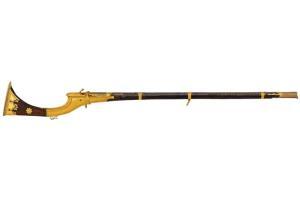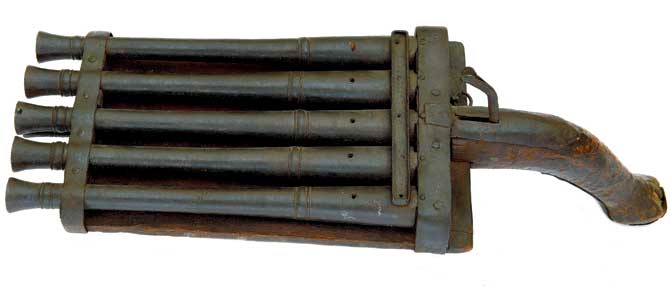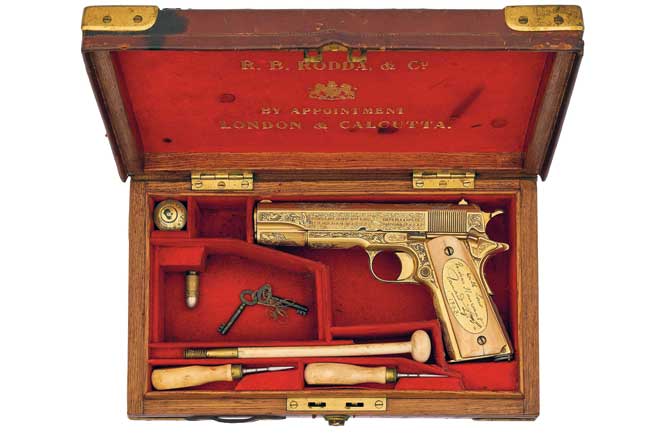
Jezail, Sindh, 19th century
For the longest time, the Rajputs showed absolute contempt for firearms. So much so, that during battle, a wound from a sword received double the compensation paid to a similar wound from a gun. In contrast, the Mughals were totally enamoured by the new war weaponry. Abu'l Fazl, the close confidante of Akbar, who authored Akbarnama, even credited the Mughal emperor for various gun inventions in his region. "With the exception of Turkey, there is perhaps no country which in its guns has more means of securing the government than this," Fazl wrote.
A new book by UK-based historical arms expert Robert Elgood takes a closer look at the Indian subcontinent's tryst with firearms, through the prism of the private collection of the Royals of Jodhpur. Showcasing some of the best Indian matchlocks, British and American sporting guns, rifles, shotguns, revolvers, and automatic pistols spanning over four centuries, Elgood's book, The Maharaja of Jodhpur's Guns (Niyogi Books), also explores how the Rajput clan, which was most resistant to firearms, embraced it, eventually. "I was invited to write the catalogue of the armoury for the Maharaja [of Jodhpur, Gaj Singh II], and I worked on it for a dozen years. But, he also wanted their guns to be included in my book. So, after working on the first two-volume book [which comprises Mehrangarh Fort's collection of swords, daggers, and assorted weapons of war and artistry], I moved on to cataloguing this one. The guns are a very important part of that collection," says Elgood,
of the book that took five years to research.
ADVERTISEMENT

Lamchar, matchlock gun, Mughal, 17th century. Pics courtesy/The Maharaja of Jodhpur's Guns by Robert Elgood, Niyogi Books
It's commonly assumed that Babur, who invaded India from Central Asia and founded the Mughal Empire, introduced cannon and firearms to the country in 1526. As Gaj Singh II also shares in the book, his clan, the warrior Rathores of Marwar, first met the firearm in 1527 at the historic Battle of Khanua. "Unfortunately, we were only on the receiving end. Babur… took my most esteemed ancestor Rao Maldev—then the heir-apparent—and his legendary cavalry completely by surprise; they were mowed down by a row of guns, matchlock and mortar, tethered together by chain," he writes.
But, the history of how firearms arrived in the region is far more complex, says Elgood. Gunpowder was a Chinese invention, and the Mongols encountered weapons that used it in wars with their Chin, Song and Tatar enemies in China in the first half of the 13th century. The technology was later carried west by them. The Mongols being extremely tolerant of certain religions, including Christianity also welcomed travelling European monks, mainly Franciscans and Dominicans. This was the time when Christian Europe was hungry for scientific knowledge, and firearms seem to have piqued their interest. "The Europeans made these weapons more effective," says Elgood, whose most noted works include Islamic Arms and Armour (1979), and Arms and Armour of Arabia (1994). Babur first received firearms from the Ottoman Turks, who in turn acquired it as part of war-loot, while expanding their empire towards Europe that had used this technology to prevent the growing Islamic tide. His grandson, Akbar, a huge collector himself, owned among other things, a multishot gun, which is likely to have come from the Portuguese. "The Portuguese in Goa tried to impress the Mughals by giving them guns. It was a way of winning diplomatic favours," says Elgood. This also explains why many of the earlier firearms owned by the Mughals were of Goan make.

Matchlock multi-barrel pistol, Panjtop or Sher Ka Bache, 18th century
The Rajputs, though, continued to keep away from any kind of sophisticated machinery, especially during battle. When Maharana Vikramaditya (reign 1531–37) attempted to arm infantry with guns at Mewar, he forfeited the support of his aristocracy. "It was unthinkable by Rajput warriors that this status could be achieved using gunpowder weapons," Elgood cites in the book. "It's difficult to say when [things changed]. While they enjoyed the guns, they didn't admire them in battle. What the Rajput warrior really liked was to have a personal hand-to-hand combat with his enemy." The Rajputs, he says, never lost their virile belief that war was a matter of individual combat for personal glory. "And it's remarkable, how they continued to keep that belief." There are accounts of them using these weapons, he says, but these occasions were few and far between. The firearms were otherwise, mostly favoured for hunting.
Incidentally, while researching the Jodhpur collection, Elgood chanced upon interesting similarities between Rajput guns, and those of their allies, the Mughals. "I was looking at some of the gun barrels, and the pattern and style is so Persian that it appears they were made my Mughal craftsmen working for the Rajputs. One of the things that I'd like to stress is that there were plenty of Muslims making weapons for the Rajputs princes, who were wealthy enough to invite and patronise good craftsmen," he says.

Holland & Holland 12 bore d/b shotgun, 1920
As far as the collection is concerned—the book comprises 350 unique images of guns and Rajput paintings—Elgood says it's difficult to pick a favourite. "Each armoury is different, partly because they reflect the taste and preferences of the Royal house that built the collection and also their history in peace and war. These are working collections, which includes presents, diplomatic gifts, purchases and object picked up on battlefields."

Cased Colt self-loading pistol, calibre .32, 1924

Robert Elgood
Keep scrolling to read more news
Catch up on all the latest Mumbai news, crime news, current affairs, and a complete guide from food to things to do and events across Mumbai. Also download the new mid-day Android and iOS apps to get latest updates.
Mid-Day is now on Telegram. Click here to join our channel (@middayinfomedialtd) and stay updated with the latest news
 Subscribe today by clicking the link and stay updated with the latest news!" Click here!
Subscribe today by clicking the link and stay updated with the latest news!" Click here!







